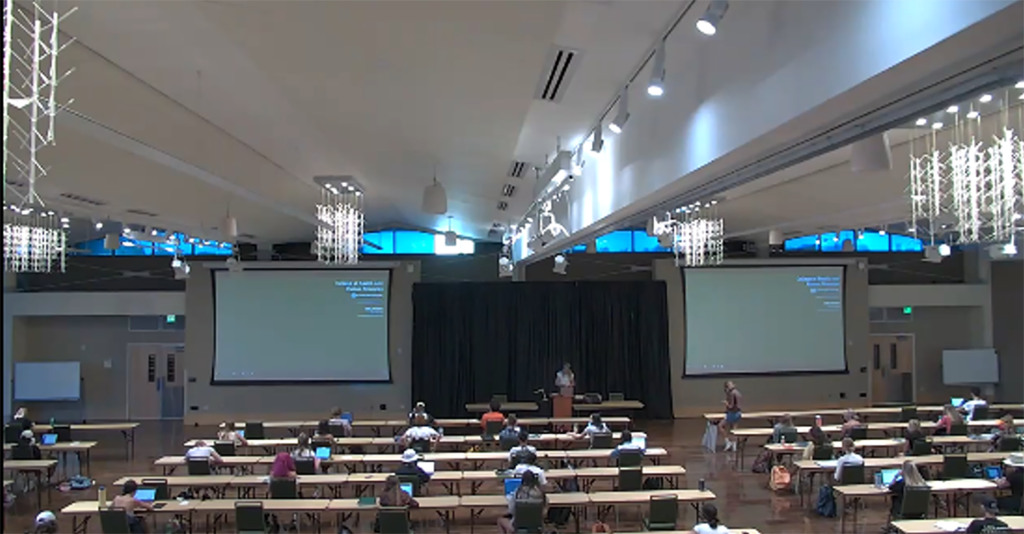
Like so many around the globe, Colorado State University professors and students have had to pivot and transition their learning experience online. For programs like Apparel and Merchandising and Interior Architecture and Design in the Department of Design and Merchandising, this has been a unique challenge as much of the classroom culture is focused on hands-on learning. Below are some examples of the creative ways the professors have found to still promote engaged learning while adhering to safety protocols.
Historic Textiles
A key part of Historic Textiles taught by Assistant Professor Katie Knowles is examining pieces from the Avenir Museum of Design and Merchandising’s large teaching collection. Even if she were teaching the class in a hybrid format, that key piece of the class curriculum would be lost in order to adhere to safety protocols while also protecting the collection. Adapting to these concerns, Knowles shifted the class entirely online and found a way to still utilize the collection.
Knowles is using skills she learned through a summer courses on online teaching taught by The Institute for Learning and Teaching at CSU to film the collection pieces and add them to the course on the student learning platform, CANVAS. Adapting in this way has brought some surprising benefits. By teaching with this method, Knowles has discovered that she is able to highlight details on the textiles in ways she previously couldn’t through in-person learning. Using videos, the students are able to see the techniques and modes of creation in real time rather than coming up in groups, one group at a time.
Other ways Knowles has pivoted is through the student’s final project. Normally, in this class, the students would pick an object from the Avenir’s teaching collection to research and study throughout the semester. This semester, each student is researching a textile they own. The specifications of the textile are anything they want to know the story behind. For each unit the class covers, they are required to explore the global historic connection to their item.
“It has been interesting,” said Knowles. “The project the way it was before online learning was a favorite part of my class to see what the students discover about their object from the collection. But now, I get to learn more about my students and who they are. The personal tie and connection to the object reflects the student’s personal story and their connection to the textile.”
Due to the project’s success, Knowles is thinking about keeping this project as a permanent part of the course.
Fashion Industries (AM101)
Fashion Industries, taught by Instructor Jennifer Jeanneret, is a first-year student course. It is designed to be an introduction course and advances working knowledge on the development, organization and trends of domestic and foreign fashion industries. This course is designed to be a large, in-person class that is normally taught at the new classrooms in the stadium. This year, to successfully practice social distancing, this course has been moved to a ballroom in the Lory Student Center.
“Overall, the new class formats have been fine. Face-to-face instruction works well in terms of building knowledge in this course,” said Jeanneret.
This course typically encourages first year students to cultivate connections with their classmates and build relationships. When moving towards practicing social distancing, that was a key element that needed to be maintained in the course. Jeanneret has found that wearing a mask has significantly reduced the engagement these students can have but by continuing to have this class in person, these students are able build some level of relationship with each other which has been critical to the first-year experience.
Jeanneret notes that the best thing to come out of maintaining in-person learning is the lifelong skill of flexibility the students are gaining throughout this year. For Jeanneret, flexibility has been critical to determining how to serve the students best, where to give leniency and how to balance personal and professional life.
For the students and combating “COVID-fatigue,” Jeanneret finds it very important to remind them how bright their futures are no matter what the world looks like.
Studio III-Interior Architecture and Design
The Interior Architecture and Design Program has had to pivot while maintaining program excellence. A large part of their program is in-person work involving projects. Because of this, IAD has heavily relied on hybrid learning models.
Studio III is a class focused on a design project in which the students work on a comprehensive design that reflects the integration of knowledge of structural and building systems. Because of this project and outline of the class, the hybrid learning model was critical to promoting an engaged learning experience. Most of the learning in this course is team-based which the hybrid learning helps to foster. This model allowed the students to have in-person classes but do most of the team collaboration on the project remotely through Teams or Zoom.
Instructor Ashley Rathman is conducting consults with teams throughout their projects, both in-person and remotely which provides the critical feedback for the students to work on collaboratively. The process has shown the creativity Rathman has dedicated to the course and engagement of students, while also adhering to social distancing protocols.
The Department of Design and Merchandising is dedicated to continuing high-quality student learning and interactions, no matter what the modality and utilizing the University resources to celebrate the student experience.
The Department of Design and Merchandising is in CSU’s College of Health and Human Sciences.